Golden Guide pages
71 to 80
.
Contents...1-10...11-20...21-30...31-40...41-50...51-60...61-70...71-80...81-90
91-100...101-110...111-120...121-130...131-140...141-150...151-156...Index
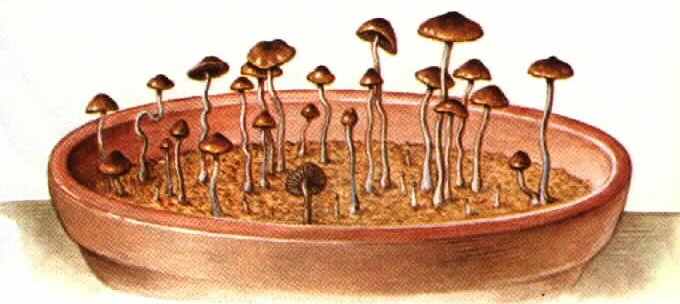 A
laboratory culture of Psilocybe mexicana, grown from spores, an innovation
that speeded analysis of the ephemeral mushroom.
A
laboratory culture of Psilocybe mexicana, grown from spores, an innovation
that speeded analysis of the ephemeral mushroom.
(After Heim & Wasson: Les Champignons
Hallucinogenès du Mexique)
CHEMICAL INVESTIGATION of the Mexican mushrooms
was difficult until they could be cultivated. They are almost wholly water
and great quantities of them are needed for chemical analyses because their
chemical constitution is so ephemeral. The clarification of the chemistry
of the Mexican mushrooms was possible only because mycologists were able
to cultivate the plants in numbers sufficient to satisfy the needs of the
chemists. This accomplishment represents a phase in the study of hallucinogenic
plants that must be imitated in the investigation of the chemistry of other
narcotics. The laboratory, in this case, became an efficient substitute
for nature. By providing suitable conditions, scientists have learned to
grow many species in artificial culture.
Cultivation of edible mushrooms is
an important commercial enterprise and was practiced in France early in
the seventeenth century. Cultivation for laboratory studies is a more recent
development.
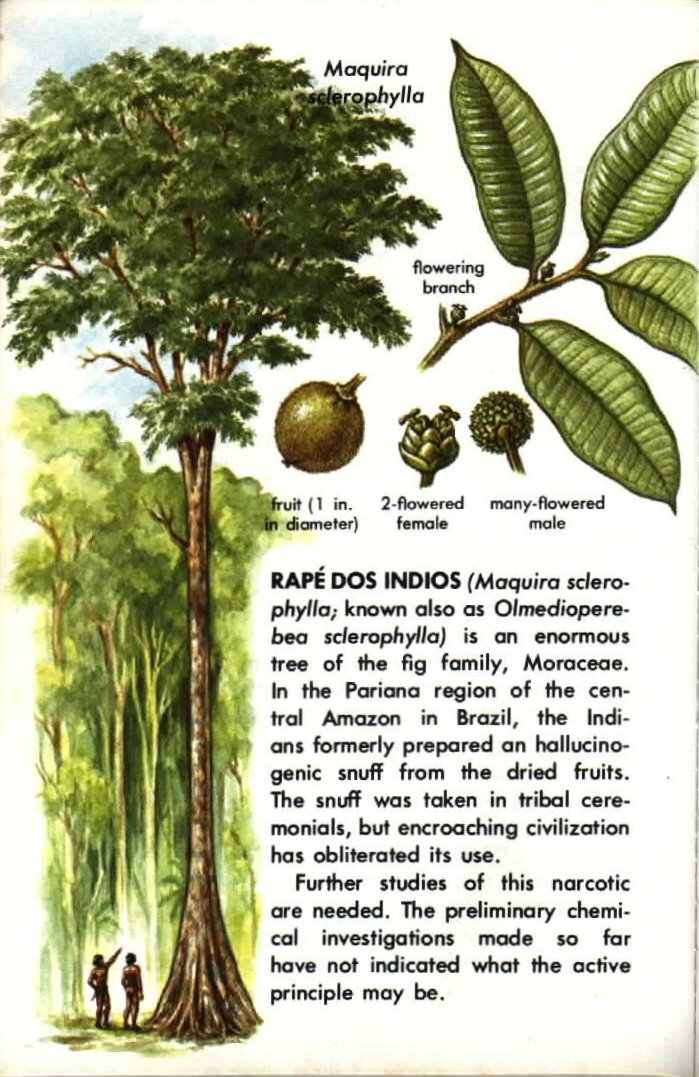
SWEET FLAG (Acorus calamus),
also called sweet calomel, grows in damp places in the north and south
temperate regions. A member of the arum family, Araceae, it is one of two
species of Acorus. There is some indirect evidence that Indians
of northern Canada, who employ the plant as a medicine and a stimulant,
may chew the rootstock as an hallucinogen. In excessive doses, it is known
to induce strong visual hallucinations. The intoxicating properties may
be due to a-asorone and ß-asarone, but the chemistry and pharmacology
of the plant are still poorly understood.
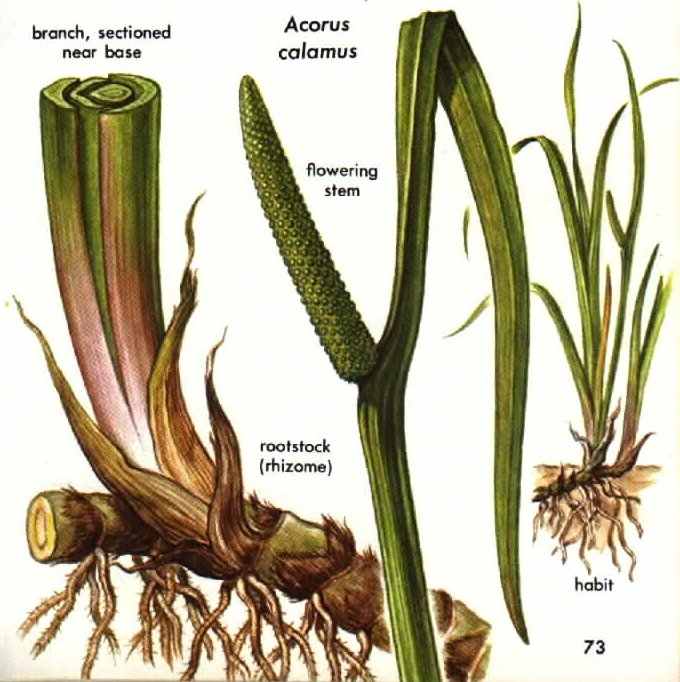
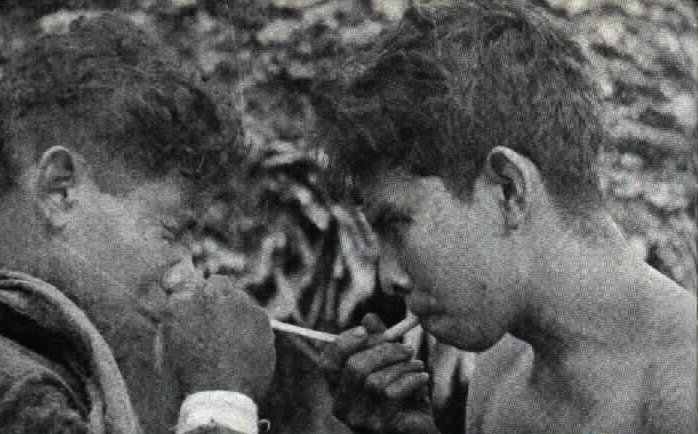
Colombian Indians using a snuffing tube
fashioned from a bird bone.
VIROLAS (Virola calophylla,
V.
colophylloidea, and V. theiodora) are among the most recently
discovered hallucinogenic plants. These jungle trees of medium size have
glossy, dark green leaves with clusters of tiny yellow flowers that emit
a pungent aroma. The intoxicating principles are in the blood-red resin
yielded by the tree bark, which makes a powerful snuff.
Virola trees are native to
the New World tropics. They are members of the nutmeg family, Myristicaceae,
which comprises some 300 species of trees in 18 genera. The best known
member of the family is Myristica fragrans, an Asiatic tree that
is the source of nutmeg and mace.
In Colombia, the species most often
used for hallucinogenic purposes are Virola calophylla and V.
calophylloidea, whereas in Brazil and Venezuela the Indians prefer
V.
theiodora, which seems to yield a more potent resin.
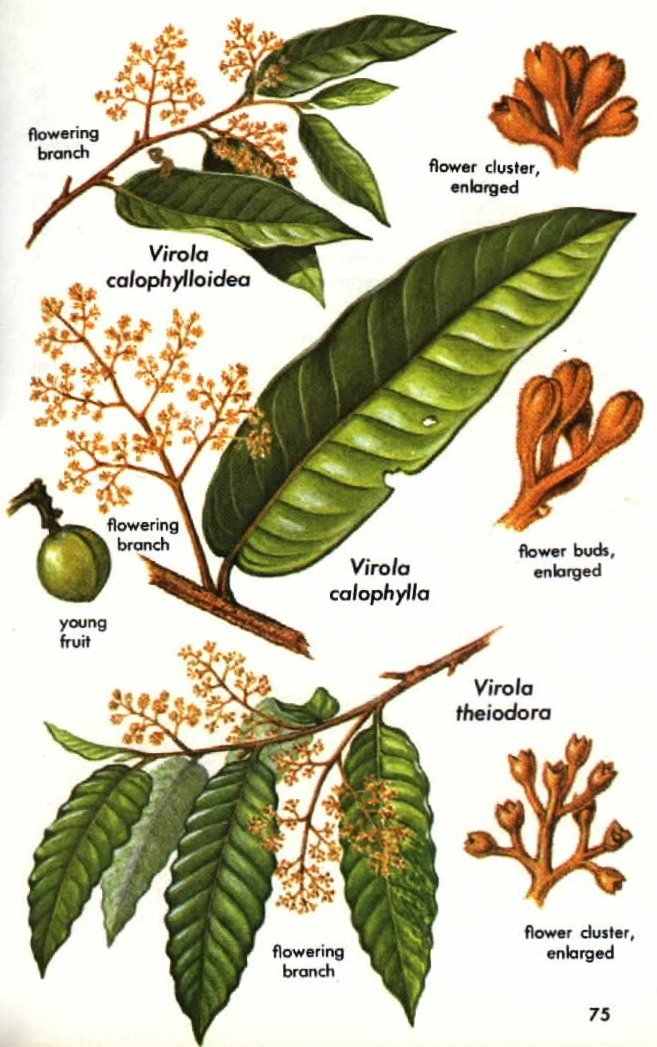
 AN
INTOXICATING SNUFF is prepared from the bark of Virola trees
by Indians of the northwestern Amazon and the headwaters of the Orinoco.
An anthropologist who observed the Yekwana Indians of Venezuela in their
preparation and use of the snuff in 1909 commented:
AN
INTOXICATING SNUFF is prepared from the bark of Virola trees
by Indians of the northwestern Amazon and the headwaters of the Orinoco.
An anthropologist who observed the Yekwana Indians of Venezuela in their
preparation and use of the snuff in 1909 commented:
"Of special interest are cures, during
which the witch doctor inhales hakudufha. This is a magical snuff used
exclusively by witch doctors and prepared from the bark of a certain tree
which, pounded up, is boiled in a small earthenware pot, until all the
water has evaporated and a sediment remains at the bottom of the pot.
"This sediment is toasted in the pot
over a slight fire and is then finely powdered with the blade of a knife.
Then the sorcerer blows a little of the powder through a reed . . . into
the air. Next, he snuffs, whilst, with the same reed, he absorbs the powder
into each nostril successively.
"The hakudufha obviously has a strong
stimulating effect, for immediately the witch doctor begins to sing and
yell wildly, all the while pitching the upper part of his body backwards
and forwards."
Strip of bark from Virola tree, showing
oozing resin.
Among numerous tribes in eastern Colombia,
the use of Virola snuff, often called yakee or parica, is restricted
to shamans. Among the Waiká or Yanonamo tribes of the frontier region
of Brazil and Venezuela, epena or nyakwana, as the snuff is called, is
not restricted to medicine men, but may be snuffed ceremonially by all
adult males or even taken occasionally without any ritual basis by men
individually. The medicine men of these tribes take the snuff to induce
a trance that is believed to aid them in diagnosing and treating illness.
Although the use of the snuff among
the Indians of South America had been described earlier, its source was
not definitely identified as the Virola tree until 1954.
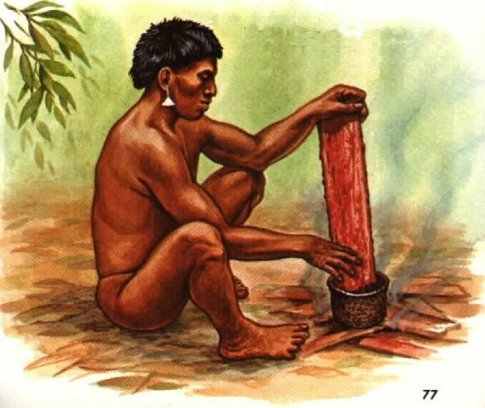
Waiká Indian scraping Virola resin
into pot, preparatory to cooking it.
PREPARATION OF VIROLA SNUFF varies among different
Indians. Some scrape the soft inner layer of the bark and dry the shavings
gently over a fire. The shavings are stored for later use. When the snuff
is needed, the shavings are pulverized by pounding with a pestle in a mortar
made from the fruit case of the Brazil- nut tree. The resulting powder
is sifted to a fine, pungent brown dust. To this may be added the powdered
leaves of a small, sweet-scented weed, Justicia, and the ashes of
amasita, the bark of a beautiful tree, Elizabetha princeps. The
snuff is then ready for use.

Dried Justicio leaves are ground before
being added to snuff
Other Indians fell the
tree, strip off and gently heat the bark, collect the resin in an earthenware
pot, boil it down to a thick paste, sun-dry the paste, crush it with a
stone, and sift it. Ashes of several barks and the leaf powder of Justicia
may or may not be added.
Still other Indians knead the inner
shavings of freshly stripped bark to squeeze out all the resin and then
boil down the resin to get a thick paste that is sun-dried and prepared
into snuff with ashes added.
The same resin, applied directly to
arrowheads and congealed in smoke, is one of the Waika arrow poisons. When
supplies of snuff are used up in ceremonies, the Indians often scrape the
hardened resin from arrow tips to use it as a substitute. It seems to be
as potent as the snuff itself.

Waika Indian sizing ground Justica leaves
to make fine powder
for additive to Virola snuff.
A SNUFF-TAKING CEREMONY is conducted annually
by many Waiká tribes to memorialize those who have died the previous
year. Endocannibalism comprises part of the rite; the ashes of calcined
bones of the departed are mixed into a fermented banana drink and are swallowed
with the beverage.
The ceremony takes place in a large
round house. Following initial chanting by a master of ceremony, the men
and older boys form groups and blow huge amounts of snuff through long
tubes into each other's nostrils (p. 74). They then begin to dance and
to run wildly, shouting, brandishing weapons, and making gestures of bravado.
Pairs or groups engage in a strange ritual in which one participant thrusts
out his chest and is pounded forcefully with fists, clubs, or rocks by
a companion, who then offers his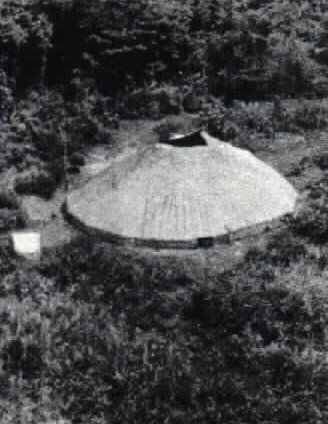 own chest for reciprocation. Although this punishment, in retribution for
real or imagined grievances, often draws blood, the effects of the narcotic
are so strong that the men do not flinch or show signs of pain. The opponents
then squat, throw their arms about each other, and shout into one another's
ears. All begin hopping and crawling across the floor in imitation of animals.
Eventually all succumb to the drug, losing consciousness for up to half
an hour. Hallucinations are said to be experienced during this time.
own chest for reciprocation. Although this punishment, in retribution for
real or imagined grievances, often draws blood, the effects of the narcotic
are so strong that the men do not flinch or show signs of pain. The opponents
then squat, throw their arms about each other, and shout into one another's
ears. All begin hopping and crawling across the floor in imitation of animals.
Eventually all succumb to the drug, losing consciousness for up to half
an hour. Hallucinations are said to be experienced during this time.
Waika round house in clearing in Amazon forest.
Contents
Next
 A
laboratory culture of Psilocybe mexicana, grown from spores, an innovation
that speeded analysis of the ephemeral mushroom.
A
laboratory culture of Psilocybe mexicana, grown from spores, an innovation
that speeded analysis of the ephemeral mushroom.




 AN
INTOXICATING SNUFF is prepared from the bark of Virola trees
by Indians of the northwestern Amazon and the headwaters of the Orinoco.
An anthropologist who observed the Yekwana Indians of Venezuela in their
preparation and use of the snuff in 1909 commented:
AN
INTOXICATING SNUFF is prepared from the bark of Virola trees
by Indians of the northwestern Amazon and the headwaters of the Orinoco.
An anthropologist who observed the Yekwana Indians of Venezuela in their
preparation and use of the snuff in 1909 commented:



 own chest for reciprocation. Although this punishment, in retribution for
real or imagined grievances, often draws blood, the effects of the narcotic
are so strong that the men do not flinch or show signs of pain. The opponents
then squat, throw their arms about each other, and shout into one another's
ears. All begin hopping and crawling across the floor in imitation of animals.
Eventually all succumb to the drug, losing consciousness for up to half
an hour. Hallucinations are said to be experienced during this time.
own chest for reciprocation. Although this punishment, in retribution for
real or imagined grievances, often draws blood, the effects of the narcotic
are so strong that the men do not flinch or show signs of pain. The opponents
then squat, throw their arms about each other, and shout into one another's
ears. All begin hopping and crawling across the floor in imitation of animals.
Eventually all succumb to the drug, losing consciousness for up to half
an hour. Hallucinations are said to be experienced during this time.